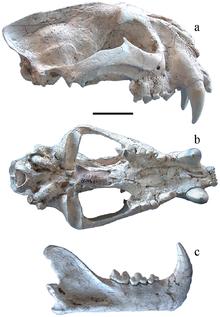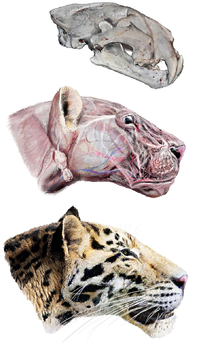Panthera zdanskyi
| Panthera zdanskyi Temporal range: Early Pleistocene,
| |
|---|---|

| |
| Holotype skull | |
| Scientific classification | |
| Domain: | Eukaryota |
| Kingdom: | Animalia |
| Phylum: | Chordata |
| Class: | Mammalia |
| Order: | Carnivora |
| Suborder: | Feliformia |
| Family: | Felidae |
| Subfamily: | Pantherinae |
| Genus: | Panthera |
| Species: | †P. zdanskyi
|
| Binomial name | |
| †Panthera zdanskyi Mazák, Christiansen & Kitchener, 2011
| |
Panthera zdanskyi is an extinct pantherine species, the fossils of which were excavated in Gansu Province, northwestern China. Due to its close relationship with the modern tiger (Panthera tigris), it is called the Longdan tiger.[1]
As of 2025, at least three recent studies considered P. zdanskyi likely to be a synonym of Panthera palaeosinensis, noting that its proposed differences from that species fell within the range of individual variation.[2][3][4]
Etymology
[edit]Panthera zdanskyi was first named by Ji H. Mazák, Per Christiansen and Andrew C. Kitchener in 2011. The specific name honors the Austrian paleontologist Otto A. Zdansky for his contributions to the understanding of Neogene Chinese fossil carnivorans.[1]
Description
[edit]The holotype of Panthera zdanskyi consists of a nearly complete skull and mandible stored at the Babiarz Institute of Paleontological Studies. It is the oldest known complete pantherine skull ever found, and it indicates that the animal was about the size of a jaguar. The paratype comprises a rostrum, premaxilla and maxilla and much of the dentition, originally referred to Panthera palaeosinensis. It was collected in 2004 in the eastern slope of Longdan, south of Dongxiang Autonomous County in the Lower Pleistocene Equus layer, dating to the Gelasian stage of the earliest Pleistocene, about 2.55–2.16 million years ago.[1]
Phylogeny
[edit]
The cladogram below follows Mazák, Christiansen and Kitchener (2011).[1]
See also
[edit]References
[edit]- ^ a b c d Mazák, J. H.; Christiansen, P.; Kitchener, A. C. (2011). "Oldest Known Pantherine Skull and Evolution of the Tiger". PLOS One. 6 (10): e25483. Bibcode:2011PLoSO...625483M. doi:10.1371/journal.pone.0025483. PMC 3189913. PMID 22016768.
- ^ Hemmer, Helmut (2023). "The identity of the "lion", Panthera principialis sp. nov., from the Pliocene Tanzanian site of Laetoli and its significance for molecular dating the pantherine phylogeny, with remarks on Panthera shawi (Broom, 1948), and a revision of Puma incurva (Ewer, 1956), the Early Pleistocene Swartkrans "leopard" (Carnivora, Felidae)". Palaeobiodiversity and Palaeoenvironments. 103 (2): 465–487. Bibcode:2023PdPe..103..465H. doi:10.1007/s12549-022-00542-2.
- ^ Jiangzuo, Qigao; Wang, Yuan; Ge, Junyi; Liu, Sizhao; Song, Yayun; Jin, Changzhu; Jiang, Hao; Liu, Jinyi (2023). "Discovery of jaguar from northeastern China middle Pleistocene reveals an intercontinental dispersal event". Historical Biology. 35 (3): 293–302. Bibcode:2023HBio...35..293J. doi:10.1080/08912963.2022.2034808. S2CID 246693903.
- ^ Jiangzuo, Q.; Madurell-Malapeira, J.; Li, X.; Estraviz-López, D.; Mateus, O.; Testu, A.; Li, S.; Wang, S.; Deng, T. (2025). "Insights on the evolution and adaptation toward high-altitude and cold environments in the snow leopard lineage". Science Advances. 11 (3): eadp5243. doi:10.1126/sciadv.adp5243. PMC 11734717. PMID 39813339.
External links
[edit]- Choi, C. Q. (2011). "World's Oldest Tiger Species Discovered". Live Science. Retrieved 2019-06-30.
